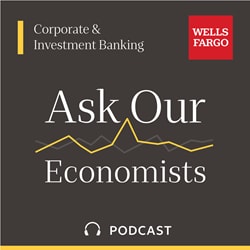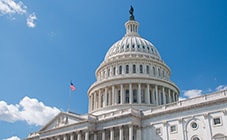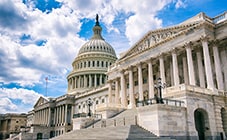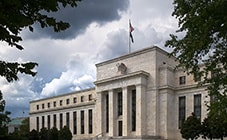>> Intro: Welcome to the Wells Fargo Ask Our Economist podcast series, where we explore what's on our clients’ minds, provide timely commentary on what's happening in the markets, and discuss our outlook for the ever-changing investment landscape. Our economists provide their views on the latest domestic and global trends, insights on the demographics, social issues and challenges that impact our world - All which helps you manage risk and capture opportunities. Join us as we take you down the road of navigating today's economic climate with confidence.
>>Jay Bryson
Hello, this is Jay Bryson, chief economist with Wells Fargo Corporate and Investment Banking. And you're listening to the Ask our Economist podcast series. Recently, there was obviously an election here in the United States in which former President Donald Trump was elected as the 47th president of the United States. And when he takes office in January, he'll have Republicans in the majority in both chambers of Congress. There's lots of implications from this particular election, and we are most interested here in the economic implications. And we're going to be talking about that. And so to talk about the economic implications, I'm joined by my colleagues, senior economist Sarah House, senior economist Michael Pugliese and international economist Brendan McKenna. Now, before we talk about the economic implications, we probably first need to talk about the policy assumptions that we're making. And I'm saying assumptions because candidates, you know, they promise lots of different things on the campaign trail and then when they get into office, not all of those promises are necessarily put into action. So to talk about some of the policy assumptions we're going to make, I'm going to turn first to Michael Plugliese. Mike, as you well know, there's lots of different policies that can be changed here. But let's start with trade policy. What sort of assumptions are we making when it comes to trade policy?
>>Mike Pugliese
Well, thanks, Jay. On the trade policy front, President Trump proposed a variety of different trade policies when it comes to tariffs. But the one he most commonly put out there was a 10% universal tariff on all imports into the United States, which total about $3 trillion annually and a 60% tariff on Chinese imports or goods that the U.S. imports from China. And we're assuming in our forecast that we get about half of that. So not the full amount, but not nothing either. And that would be a pretty substantial increase in tariff rates, much larger than what we got in the first term of Donald Trump's administration when he raised tariffs on a few different countries, mostly China, but nothing near 60% and certainly not a universal tariff on all the goods imported from the 200 and more countries from around the world. And in terms of timing, now, this is an area the president has a lot of unilateral control. The president has the power to raise and implement tariffs relatively quickly and without Congress compared to some of the other policy areas we'll talk about in a bit. So this is one of the policy areas where we assume some faster action. And in fact, we're assuming that these tariffs go into effect in around the third quarter of next year. And of course, there are risks to these forecasts. Maybe it'll be sooner, maybe it'll be later. You know, maybe we won't get tariffs this high. But, you know, in contrast, there's a chance we get the full ten and 60% or maybe even higher than that. So this strikes, I think, a pretty balanced approach of a big and meaningful tariff increase relatively quickly into President Trump's first term, but not necessarily the full amount that he proposed on the campaign trail.
>>Jay Bryson
Okay. That's for trade. Now, President elect Trump also talked about taxes and spending, fiscal policy changes on the campaign trail. What are we assuming there in terms of fiscal policy?
>>Mike Pugliese
This starts in terms of fiscal policy and tax policy with the 2017 tax cuts. So back then, under President Trump and congressional Republicans, those policymakers enacted a series of tax cuts for households and businesses with most of the business tax cuts being permanent. But most of the household tax cuts slated to expire if that expiration happening at the end of 2025, because those tax cuts were not offset with other revenue increases or spending cuts. They had to have an expiration date given the rules of of budget reconciliation, the tool that that Republicans used to pass that bill. And so, as a result, large parts of the household section of the 2017 tax cut bill are set to expire at the end of next year. So if Congress does nothing, taxes will rise across the board on most U.S. households. Now, it's our expectation Republicans will extend those tax cuts. This was a landmark achievement of President Trump and the Republicans last time. It would surprise me if they allowed it to lapse. But it's a tricky question. It took a year just to pass that bill the first time. And I expect there to be a lot of policy discussions about what exactly is going to be kept and extended. In addition to that, it's important to remember that this does not reduce taxes on anyone. It just prevents taxes from going up. So a second discussion Republicans are going to have to have is do they want to make the tax cuts even larger than just extending what is expiring? So our base case is that the 2017 tax cuts will be extended. That's been in our forecast for a while now. That's not a new post-election development, but we're also assuming that we get some new tax cuts on the order of about $100 billion annually, a trillion over a decade, if you prefer that convention, with most of those tax cuts targeted to households. So not as much on the corporate or business side. Think things like expanding the child tax credit, increasing the standard deduction, tax items like that. And that's a 2026 story in our forecast. We think it's going to take the better part of next year before that bill is written and passed and debated and eventually becomes law. So that's really not an impact we're going to see, I think in 25 the debate will happen in 25, but more of a 2026 story for the economy.
>>Jay Bryson
Okay. Well, great. So any other major policy changes as it relates to, say, regulatory policies and immigration policies, what sort of assumptions are we making there?
>>Mike Pugliese
Yeah, there's probably a little bit of upside risk for economic growth in the economy just from a more lenient regulatory environment. Although again, I would caution kind of like the tax cuts. I think that's more of a multiyear story. I don't think that's something you're going to see in first half of next year GDP growth or a CPI print come next May. But over time, I think that provides a little bit of upside risk. Not big numbers, but modest. That being said, there's probably a little bit of downside risk from the immigration side where President Trump has talked about significant deportation of undocumented immigrants, as well as slowing the pace of immigration into the United States pretty sharply. We were already seeing this a little bit. So immigration into the United States looks like it's slowed quite a bit from undocumented immigrants over the past several months. And we've got that continuing into next year. So to put some numbers around it, the labor force grew one and a half, 2% over 2022 and 2023. That's that's pretty robust growth and contributed to some of the strong jobs numbers and stronger economic growth we saw in that period. That's not our base case going forward. We're looking for more like half a percent, three quarters of a percent in the labor force with the story there really being one of much, much slower immigration into the U.S. and not necessarily a whole lot on the mass deportation side, although that is a risk to the forecast. But just, you know, not seeing the 3-ish million pace of new kind of foreign born workers coming into the labor force that we've seen over the past couple of years.
>>Jay Bryson
Okay, great. Well, thanks, Mike, for level setting there in terms of different policy sorts of assumptions. So let's shift gears now and let's start talking about the economic implications of some of those policy changes. So, Sarah, I'm going to bring you in here and ask you, what do you think this does for GDP growth and inflation in 2025 and 2026? You know, in light of these policy assumptions that we have.
>>Sarah House
Sure. Thanks, Jay. So I think ultimately, the policy assumptions that we have, particularly for 2025, it points to slower growth next year. So when you think about tariffs, ultimately, this is a tax. So to the extent that businesses can absorb some of it, it does at least lead to lower profits, which can weigh on hiring and investment. And to the extent that it's passed on to consumers that weighs on their spending power via higher inflation. So we're looking for growth to slow next year, particularly in the second half, led by some softening in consumer spending. So we're looking at about 2% in terms of GDP growth, in inflation adjusted terms for the full year, but probably seeing real GDP growth slow to about 1.5% in the fourth quarter of next year. Now, we do think growth will pick up in 2026 as that initial shock from tariffs fade as well as you get some potential expansion in terms of the tax cuts. And that should lead to activity accelerating over 2026 and getting probably closer to around 3% by the end of that year. But in terms of inflation, we're also looking at a higher pat of inflation than we were before. So we're already looking for more incremental improvement on the inflation front next year. But with tariffs now, we're probably going to see inflation about maybe 3/10 or so higher than our pre tariff baseline. So if you're thinking about this in terms of the Fed's core PC--- deflator, which they like to look at to benchmark policy, we think that'll be up about two. Point 6% in the fourth quarter of next year versus about 2.8% for for the current quarter. So overall, basically getting stuck at roughly two and a half to two closer to 3% next year. Now, we do think that as the effects from tariffs fade over 2026 will begin to see inflation recede again. But with the potential tax expansion improving demand, that it can be pretty slow. So still probably looking at inflation above target through our forecast horizon through 2026.
>>Jay Bryson
So for 2025, we're looking at maybe slower growth, but higher inflation, is that right?
>>Sarah House
Right. So slower growth for 2025, but higher inflation.
>>Jay Bryson
That sounds like to me like a little bit of a conundrum for the Federal Reserve. Slower growth. You want to cut rates, higher inflation, you want to raise rates. What do we think the Fed's going to do with all of that?
>>Sarah House
Yeah, So it is going to be a tough situation for the Federal Reserve. One thing to note is that the labor market so that's part of their mandate. That's in a pretty good place right now. So we've seen the unemployment rate, it's moved up, but at 4.1%, it's within their estimates for where it should be in the long run to be consistent with the inflation side of their mandate. And so the Fed wants to keep that there, even as they're still battling with above target inflation. So we think given where the labor market is, there's probably still some further easing in store over the next year, but probably not much given that it's harder to justify with this inflation backdrop. Now, tariffs, I think, would be a situation where they would try to look through that inflationary shot given as you highlight that it's going to also depress growth. But that's harder to justify now that we've had inflation above target for almost four years now. And then if there's a lot of talk about expanding some of the tax cuts that would boost demand in 2026, it would look like maybe inflation wouldn't be receding as as quickly following that tariff shock. So we think there's still probably some further easing in store over the next year or so. We have the Fed cutting about 100 basis points from where we are today, which would bring the Fed funds rate to a range of 3.5% to 3.75%. So that's about 50 basis points le----ss easing than what we had previously. But that still leaves policy at a rate that we think is is still restrictive in terms of overall economic activity.
>>Jay Bryson
Up to this point, we've been very, very high level talking about overall GDP growth, the overall inflation. Are there any particular sectors of the economy that you may feel may be impacted by some of these policy changes? Briefly, walk through some of those different sectors of the economy.
>>Sarah House
Right. So I think given that you're going to see higher inflation coming from the tariffs, that we expect some of this to be passed on to consumers. So that's an area where we're looking for activity to soften over the course of next year. So looking for for somewhat softer consumer spending. So still growing in real terms, but just not as fast as the roughly 3% pace that we saw over the past year. Other areas that we're thinking are also going to contribute to the slower pace of GDP growth next year. Are some of the more interest rate sensitive areas, given that we're not expecting a big, big drop in rates and rates are likely to remain elevated from at least the standards of of recent history. When we look at the housing market, for example, our expectation is that mortgage rates, which are currently about 6.8% and if you're looking at a 30 year fixed rate mortgage, that's still probably going to be above 6% next year. So still well above what's the prevailing effective rate for current mortgages outstanding. And so I think you're going to see a lot of the same challenges that we've had over the past couple of years continue to linger. So things like low inventory of existing homes for sale as current mortgage owners just don't want to give up their significantly lower rate than what the current rate is. That limited inventory is likely to continue to put some upward pressure on prices and ultimately with with mortgage rates still above 6%, affordability is still going to be a big challenge for a lot of buyers and with it still very challenging from an affordability perspective to get in homes, that's going to be tough on new construction as well. So when you also layer in the fact of potentially higher material costs coming from tariffs, maybe higher labor costs, if you see a big crackdown on immigration, we're looking at probably new housing starts decreasing 2 to 3% next year. So essentially a drag from from residential investment and probably also a drag in terms of nonresidential outlays, too, as we see really just some of the lingering effects from the tighter policy. So a lot of commercial construction projects. They require a long lead time in terms of planning. And so we're still really feeling the impact of the higher rate environment and the tighter credit environment of the past couple of years. So that's another area that we look to be a drag on growth. But I will think you'll see at least some improvement in other areas of business investment like equipment, for example, which doesn't have quite the same long lead time that you see in nonresidential structures. And so getting at least a little bit of a reduction in borrowing rates, we think will help equipment spending next year.
>>Jay Bryson
Okay. Well, thank you for that, Sarah. So, Brendan, let's bring you in here now and talk about the effects that these policy changes and, you know, the economic implications the United States may have on some of our major trading partners, particularly if, as Mike talked about, the U.S. ends up enacting some tariffs. So let's talk about, you know, the so-called G10 economies of the world, some of the other advanced economies of the world. What sort of effects do you see this happening on those economies?
>>Brendan McKenna
Yeah. Thanks, Jay. And this is a topic that we made a point of highlighting in the Outlook publication. And basically, we made the point that in a scenario where new U.S. tariffs are imposed, trade linkages to the U.S. and overall exposure to tariffs will be a rather determining factor for which economies are most impacted, but also the economies that can be a bit more resilient. And for the G10 economies specifically, most of those economies maintain a degree of trade linkage to the U.S. But trade relationships with the United States are relatively modest in nature. So in the case of the eurozone and the United Kingdom, trade with the U.S. is really not all that sizable. So there is some insulation there. I would also note that economies such as the Eurozone, the United Kingdom and even Japan are large enough and diversified enough to the point where tariffs may not have a material impact. So for most of the G10 economies, their respective central banks are also going to be easing monetary policy in 2025. So lower interest rates can also support economic activity despite any tariffs that may be imposed going forward. The one G10 economy that maybe is a bit more exposed would be Canada. Canada has a really strong trade connection with the United States. And tariffs on Canada could be a bit more consequential. I would just caveat that by saying that Canada's economy has become more service oriented rather than reliant on goods exports. So maybe that vulnerability has come down over the last couple of years or so. And then we also have the Bank of Canada that's probably going to be easing monetary policy rather quickly as well. So maybe the negative impact on Canada could also be somewhat mitigated. So all in Jay, we really haven't made that material of adjustments to our outlook for G10 economies as a result of the new administration.
>>Jay Bryson
So let's just broaden our lens now and let's look at some of the emerging economies of the world. Obviously, there's a lot more emerging economies out there than there are advanced economies. Any effects on emerging economies? And if so, any any particular economies you think about here?
>>Brendan McKenna
Yeah. As far as the emerging economies and even the developing economies, the takeaway is actually pretty similar in the sense that tariff exposure can be an influence on growth prospects. But I would say that emerging market economies at a relatively high level are more vulnerable relative to the G10 economies. Emerging economies tend to be less diversified, a little bit more reliant on trade. So tariffs can impact developing economies a bit more acutely. But to your question, Jay, on economies that may be particularly sensitive, it seems like China and Mexico are particularly vulnerable in this type of environment. I'll start with China. In the case of China, you know, we don't think tariffs will materially disrupt the Chinese economy. There could be a greater impact this time around relative to Trump's first term and first batch of tariffs. But China has some pretty unique policy responses that it can deploy to mitigate the impacts. Those policy options include allowing for a weaker currency just to maintain a degree of trade competitiveness, but also using circumvention to avoid tariffs. So essentially using proxy nations to reroute exports into the United States. Those are policy tools that China used in 2018 and 2019, and we would expect them to be used again. So while we revised our 2025 GDP forecast lower, we really didn't make all that material of changes to the growth outlook for China. In the case of Mexico, Mexico is very reliant on trade with the US and does not have those same types of policy mechanisms that China has. Sure, the central bank can lower interest rates more aggressively, but that risks a sharply weaker currency, which in turn risks financial stability and also generates potential inflationary pressures as well. And then on the fiscal side, Mexico is running a very large fiscal deficit. We also have seen the sovereign debt burden trend higher over time. If fiscal policy loosens to support activity, Mexico's investment grade credit rating could also be at risk there. And maybe there is broader capital outflows and renewed downward pressure on the economy. So really, the combination of strong trade linkages, limited policy space means Mexico is significantly more vulnerable within the emerging market space. And it's probably a scenario that pushes Mexico's economy into recession in 2025. Okay, So let's talk finally about about the effects on the US dollar. So President elect Trump on the campaign trail was talking about he was going to have a weaker dollar to help U.S. exports. Is that how you see things developing here? Yeah, good question, Jay. We actually see things a little bit differently for for the U.S. dollar. And at a very high level, we do believe that the dollar can strengthen very broadly and very significantly going forward. As Sarah mentioned a little bit earlier, it looks like the Fed is likely to become a little bit less dovish going forward. And at the same time, maybe some foreign central banks have actually hinted at turning a bit more dovish in 2025. So purely from a divergent monetary policy path, it looks like the interest rate differentials will favor the United States and the U.S. dollar in 2025. And that'll be a key pillar of support for the dollar. But tariffs can also have a bit of a benefit for the dollar as well. And I say benefit in the sense that tariffs will likely negatively impact imports and that should actually improve the U.S. current account deficit and the trade deficit. That's a dynamic that can support the dollar. We're also looking at a scenario where if tariffs do come on, there's a decent chance that financial market volatility will ensue and market participants may actually be enticed to seek out the safe haven qualities of the dollar, despite the source of uncertainty coming from U.S. policy. So for the dollar index, we're actually looking at a scenario where the external and maybe also the domestic backdrop evolves in a way where the U.S. dollar rallies to levels that were last seen in 2002. But to your question, Jay, about, you know, President Trump having a preference for a weaker dollar, we actually believe he'll face multiple challenges to kind of manufacturing dollar depreciation, at least unilaterally. And we think that if dollar depreciation were to kind of be manufactured, he would really need the support of the Fed in order for the dollar to weaken rather meaningfully. But with that said, we have our doubts that the Fed would really ignore its inflation and employment mandate and set monetary policy in a way that's purely designed to artificially weaken the dollar. Setting monetary policy to appease the president's agenda would likely risk its independence and credibility as an institution. And we have our doubts that that's a tradeoff the Fed would be willing to entertain.
>>Jay Bryson
Okay. Well, thank you, Brandon, and thank you, Sara. And thank you, Mike, for joining us today. So remember, a lot of these policy assumptions that we're making right now are just that they're assumptions. And, you know, once the new administration takes office in January, once new Congress gets seated, some of these policy assumptions will actually turn into real policies. And we'll know more as time goes on. And we may need to make some adjustments to our forecast depending on how those policies evolve going forward. So this story clearly is not over. And as we continue to think about our forecasts, as we make any changes to that, we'll be sending those out in written communication. And we also may revisit it as well in some of these podcasts. So again, thank you all very much for for joining us today.
>>Outro:
That’s all for this episode of the Ask Our Economists podcast and we thank you for joining us. If you enjoyed today’s episode, please share with colleagues, family, friends, and anyone who listens to podcasts. If you have any economic related questions or topics you would like to hear about in an upcoming episode, please email us at askoureconomists@wellsfargo.com. Ask Our Economists is produced by Wells Fargo.
>>Disclosures:
This report is produced by the Economics Group of Wells Fargo Bank, N.A. (“WFBNA”). This report is not a product of Wells Fargo Global Research and the information contained in this report is not financial research. This report should not be copied, distributed, published or reproduced, in whole or in part. WFBNA distributes this report directly and through affiliates including, but not limited to, Wells Fargo Securities, LLC, Wells Fargo & Company, Wells Fargo Clearing Services, LLC, Wells Fargo Securities International Limited, Wells Fargo Securities Europe S.A., and Wells Fargo Securities Canada, Ltd. Wells Fargo Securities, LLC is registered with the Commodity Futures Trading Commission as a futures commission merchant and is a member in good standing of the National Futures Association. WFBNA is registered with the Commodity Futures Trading Commission as a swap dealer and is a member in good standing of the National Futures Association. Wells Fargo Securities, LLC and WFBNA are generally engaged in the trading of futures and derivative products, any of which may be discussed within this report.
This publication has been prepared for informational purposes only and is not intended as a recommendation, offer or solicitation with respect to the purchase or sale of any security or other financial product, nor does it constitute professional advice. The information in this report has been obtained or derived from sources believed by WFBNA to be reliable, but has not been independently verified by WFBNA, may not be current, and WFBNA has no obligation to provide any updates or changes. All price references and market forecasts are as of the date of the report or such earlier date as may be indicated for a particular price or forecast. The views and opinions expressed in this report are those of its named author(s) or, where no author is indicated, the Economics Group; such views and opinions are not necessarily those of WFBNA and may differ from the views and opinions of other departments or divisions of WFBNA and its affiliates. WFBNA is not providing any financial, economic, legal, accounting, or tax advice or recommendations in this report, neither WFBNA nor any of its affiliates makes any representation or warranty, express or implied, as to the accuracy or completeness of the statements or any information contained in this report, and any liability therefore (including in respect of direct, indirect or consequential loss or damage) is expressly disclaimed. WFBNA is a separate legal entity and distinct from affiliated banks, and is a wholly-owned subsidiary of Wells Fargo & Company. © 2024 Wells Fargo Bank, N.A.
Important Information for Non-U.S. Recipients
For recipients in the United Kingdom, this report is distributed by Wells Fargo Securities International Limited ("WFSIL"). WFSIL is a U.K. incorporated investment firm authorized and regulated by the Financial Conduct Authority (“FCA”). For the purposes of Section 21 of the UK Financial Services and Markets Act 2000 (the “Act”), the content of this report has been approved by WFSIL, an authorized person under the Act. WFSIL does not deal with retail clients as defined in the Directive 2014/65/EU (“MiFID2”). The FCA rules made under the Act for the protection of retail clients will therefore not apply, nor will the Financial Services Compensation Scheme be available. For recipients in the EFTA, this report is distributed by WFSIL. For recipients in the EU, it is distributed by Wells Fargo Securities Europe S.A. (“WFSE”). WFSE is a French incorporated investment firm authorized and regulated by the Autorité de contrôle prudentiel et de résolution and the Autorité des marchés financiers. WFSE does not deal with retail clients as defined in MiFID2. This report is not intended for, and should not be relied upon by, retail clients.

 Sign On
Sign On  The “Ask Our Economists” podcast is a series where we explore what’s on our clients’ minds, provide timely commentary on what’s happening in the markets, and discuss our outlook for the ever-changing investment landscape. Our Economists provide their views on the latest domestic and global trends, insights on the demographics, social issues, and challenges that impact our world all which help you manage risk and capture opportunities. Join us as we take you down the road of navigating today’s economic climate with confidence.
The “Ask Our Economists” podcast is a series where we explore what’s on our clients’ minds, provide timely commentary on what’s happening in the markets, and discuss our outlook for the ever-changing investment landscape. Our Economists provide their views on the latest domestic and global trends, insights on the demographics, social issues, and challenges that impact our world all which help you manage risk and capture opportunities. Join us as we take you down the road of navigating today’s economic climate with confidence. 
















